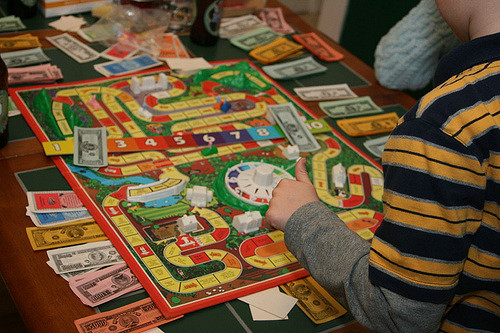
Caption: photo of woman playing tennis (Skeeze/Pixabay)
After hearing several references to a 1973 book called Extraordinary Tennis for the Ordinary Player by Simon Ramo, I decided to give it a read. I was wowed! It’s not because I used it to improve my game. In fact, you might be surprised to learn that I don’t play tennis, and I don’t plan to start because I read the book. What compelled and excited me was the bigger lesson conveyed by the book.
Ramo describes how in amateur tennis, about 80 percent of points are lost, not won. Lost points, as defined by Ramo, are those resulting from a player making an unforced error, such as hitting an easy return out-of-bounds, rather than hitting a brilliant shot that is impossible for an opponent to return. The lesson is that the vast majority of amateur tennis players will have much more success by working on “not losing,” rather than by trying to “win.”
I was struck by the fact that this simple idea is transferable to nearly every aspect of one’s life. Here’s how I think it can be applied to not be a loser in the game of life.

Caption: Photo of family playing “The Game of Life” (Kathryn/Flickr)
A Bit More About Dr. Ramo… and Tennis
Simon Ramo was a prominent American physicist, engineer, and businessman. Later in his life when he wanted to improve his tennis game, he applied the same rigorous, evidence-based approach that led to his successful career.
As a scientist and statistician, he gathered data by simply counting points won versus points lost. What he discovered is that in amateur tennis, the game’s outcome is determined by the player who makes the most mistakes. Thus, the best strategy to win in amateur tennis is to keep the ball in play, allowing the other player to make more errors. Occasionally, your opponent will hit a shot you can’t return. More frequently, however, he or she will hit it into the net or out-of-bounds, or fail to return it at all.
Keep in mind that Ramo discovered that outcomes in professional tennis work the opposite way – about 80 percent of points are won. That is, the professionals who win hit extraordinary shots that are essentially impossible to return. So, unless you are one of those professionals, the best way to win is to avoid losing!
Transferring Tennis Lessons to Life Lessons
Domain independence is the idea that certain knowledge may be applicable across other fields. I think Ramo’s insights into tennis can be considered domain independent for many other endeavors.
“In order to succeed it is necessary to know how to avoid the most likely ways to fail.” When I first read this statement, referred to as Minsky’s Admonition in The Systems Bible, it struck me that it could have been lifted directly from Dr. Ramo’s book on tennis. Hyman Minsky was an American economist whose research attempted to provide an understanding and explanation of the characteristics of financial crises.
I doubt there was ever any collaboration between Ramo and Minsky, so I take this as evidence of domain independence. Two different people, researching two completely different subjects, have come to the same conclusion on achieving success!
Here are a few other areas where I think this concept may apply.
Investing
In the classic investment book Winning the Loser’s Game, Charles Ellis makes the case that investing works much the same way as tennis. Ellis proposes that most investors, like most tennis players, end up defeating themselves by making avoidable mistakes. Like Ramo, Ellis uses compelling mathematical evidence to make his arguments.
Consider, for example, some statistics: The average annual compounded return of the broad US stock market, as measured by the S&P 500 Index, for the past 30 years was just over 10%. For that same period, the average individual investor in stock market funds achieved a return of slightly less than 4%. For an individual investing $300 a month in a retirement account over 30 years, this is a difference of having about $650,000 versus $200,000.
Why do most investors underperform the market by so much? While a fraction of the underperformance can be attributed to trading costs and other fees, Ellis explains that most investors are like amateurs playing tennis. That is, they think they can outperform the market by attempting brilliant, “winning” moves, but by doing so make unforced errors. One such error is trying to “time” the market through a pattern of buying and selling. Another error includes buying into “hot” funds or individual stocks – those that have had recent superior performance – and selling losers. These actions, more often than not, lead to buying high and selling low, the exact opposite of a winning strategy. Also, paying high fees to funds you expect to outperform will usually lead to underperformance. Funds that charge high fees, on average, underperform funds with low fees. One might get lucky once in awhile, but over time these actions lead to the huge discrepancy between the market performance and average individual performance.
What’s the best way to avoid these investment mistakes and achieve results close to the market average? It’s the same as in tennis: just work on “not losing.” For individual investors with a long-term time horizon, the best option is to systematically invest in a low cost fund that tracks a broad market index, such as the S&P 500, or a global index such as the MSCI ACWI, which includes the US and most other world markets. Put your money into these investments incrementally over time and leave it there, at least until you are close to retirement.
Health and Fitness
Ramo lists a group of “don’ts” for tennis – those behaviors, characteristic of many amateur players, which should be eliminated. Simply focusing on reducing, and preferably eliminating, these actions can significantly improve one’s play. As in tennis, improvements in health and fitness can come from the elimination of harmful actions.
According to the ongoing Global Burden of Disease study, tobacco use is the leading cause of preventable death in the US and the world. Diet is the second highest risk factor after smoking. Many diet-related diseases are the result of overconsumption of calories in the form of simple sugars. Additionally, increasing death rates from the abuse of alcohol and opioids in the US has been widely acknowledged as a public health crisis.
It may take you a bit of reframing to view behaviors such as smoking, poor eating, and drug abuse as errors. Additionally, identifying these errors is usually pretty simple, but eliminating them can be extremely difficult. Behavior change is hard. Here is an article I found useful on how to avoid impulsive temptations, and one on building willpower.
Many of us think improving our fitness is only possible by adding activities to our routines, such as going to the gym or taking up running. Consider, however, some things we can eliminate to get actually more exercise.
How many times have you stood on an escalator, or ridden an elevator, only to find that someone who took the stairs arrived at the same destination as quickly as you? Do you have the opportunity to walk or ride a bike to some destinations, rather than take a car or bus?
By framing some of these modern conveniences as errors to eliminate, you may be able to improve your fitness without sacrificing time or money. There may be tremendous opportunity for improving your health and fitness by just working on eliminating some things you are doing, rather than doing more.
Diminishing Returns
Learning to avoid mistakes may be one of the fastest and easiest methods of improving. Have you ever noticed how quickly you can improve when you start learning something new, especially if you’ve had the opportunity to learn from a good coach or teacher? I’ve really enjoyed watching children learn a new activity from a good coach, whether it be playing a sport, or even a board game requiring some skill.
It seems to me that most of their improvement, at least initially, comes from learning how to avoid mistakes. Of course, those improvements usually tend to slow down over time, a phenomenon known as diminishing returns. As we improve, it naturally gets harder to keep up that rate of improvement, or learning curve. Perhaps most of that rapid improvement comes from simply learning to not make mistakes. Keep this in mind to avoid frustration. The more you improve, the harder it may be to become even better.
…But Will This Approach Lead To Mediocrity?
By now you may be thinking “If all I do is focus on not losing, won’t I just be mediocre in everything?” No doubt many of us can and do achieve greatness in some domains, but consider these two points:
1) Since no one starts off anything at a high level of expertise, why not begin by “not losing” and learn first to avoid errors?
2) Even people talented, dedicated, and lucky enough to achieve greatness in one or two fields will undoubtedly be closer to ordinary in many other areas. It is important to recognize at what, if anything, you are truly great or desire to be great, and what falls in your “ordinary” range.
Let’s consider an example of how someone at the top of their field could have used this approach for a better outcome in another endeavor. History is filled with many top performers in one field having disasters in other areas. In 2009, Sports Illustrated estimated that 78% of NFL players have gone bankrupt or have been in financial stress within two years of retirement, and that 60% of former NBA players are broke within five years of retirement. Considering that the average annual salary of these professionals in 2012 was about $2 million and $5 million, respectively, this seems unbelievable.
Sticking to our tennis theme, consider the case of Bjorn Borg. Undoubtedly the greatest tennis player of his time, and considered by many one of the greatest ever, Borg won 64 titles, including 11 Grand Slams, over a 10 year career. His tournament earnings alone, in today’s dollars, were about $15 million. Borg retired from professional tennis in 1983 and pursued business opportunities. By 1990 his companies collapsed and were declared bankrupt. In 2006, Borg was forced to sell off many of his trophies to achieve “financial security”.
According to tennis writer Richard Evans, Borg “was much too trusting. He made bad choices which led to bad luck.”
Perhaps Borg, and many other top athletes, fall into the trap of approaching personal finance in the same manner as winning in their professional field. Maybe Borg would have fared better by approaching his businesses and personal finances from an “ordinary” perspective, at least until he developed into an extraordinary businessman.
The Relativity of Ordinary
Being a scientist, Ramo paid homage to Albert Einstein by invoking the term relativity. What if, relative to your opponent, you are the equivalent of a pro? In this case, Ramo’s advice for tennis should not be taken as absolute, but should be adapted for the situation.
Perhaps, given a weaker opponent, you can benefit by trying a more aggressive court position, much like a professional. You can use this adaptation in other areas of life too. As you improve and get closer to a professional level, consider some actions that challenge your abilities. Just don’t try these during a critical “match” point. For example, if you’re just learning how to drive, you might want to practice in an empty parking lot, maneuvering around rubber cones, before you cruise through busy city streets. It’s OK to make some errors, providing you learn from them and you are willing to accept their consequences.
What if, on the other hand, you really are a pro player, but your play has become a little erratic and you are temporarily making more errors? It can be difficult admitting part of your game is ordinary. If this is your case, Ramo suggests considering that you may be only a bit ordinary. You are still eligible to benefit from working on winning by not losing, and by eliminating errors.
As Ramo puts it, you can improve, going from “ordinary” to “ex-ordinary,” whether or not you ever become extraordinary.
Questions to Ask Yourself
- What are some areas in which you can benefit by taking the ordinary approach, as in working on not losing, and eliminating errors?
- What are some actionable steps you can take to go from “ordinary” to “ex-ordinary”?
- How can you apply a simple measurement of your performance, as Ramo did in tennis using points lost versus points won?




